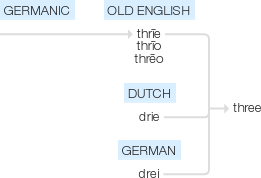Three
Old English thrīe (masculine), thrīo, thrēo (feminine), of Germanic origin; related to Dutch drie and German drei, from an Indo-European root shared by Latin tres and Greek treis .
wiktionary
From Middle English thre, threo, thrie, thri, from Old English þrī, from Proto-West Germanic *þrīʀ, from Proto-Germanic *þrīz, from Proto-Indo-European *tréyes. Doublet of trey.
Cognates with German drei, Albanian tre, Armenian երեք(erekʿ), Latvian trīs, Lithuanian trỹs, Greek τρεῖς(treῖs), and others.
etymonline
three (adj., n.)
"1 more than two; the number which is one more than two; a symbol representing this number;" Old English þreo, fem. and neuter (masc. þri, þrie), from Proto-Germanic *thrijiz (source also of Old Saxon thria, Old Frisian thre, Middle Dutch and Dutch drie, Old High German dri, German drei, Old Norse þrir, Danish tre), from nominative plural of PIE root *trei- "three" (source also of Sanskrit trayas, Avestan thri, Greek treis, Latin tres, Lithuanian trys, Old Church Slavonic trye, Irish and Welsh tri "three").
3-D first attested 1952, abbreviation of three-dimensional (1878). Three-piece suit is recorded from 1909. Three cheers for ______ is recorded from 1751. Three-martini lunch is attested from 1972. Three-ring circus is recorded by 1898. Three-sixty "complete turnaround" is from 1927, originally among aviators, in reference to the number of degrees in a full circle. Three musketeers translates French les trois mousquetaires, title of the 1844 novel by Alexandre Dumas père.
